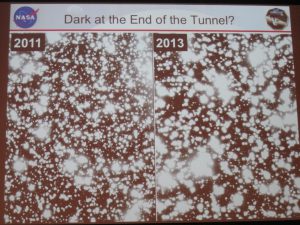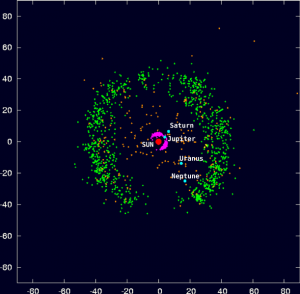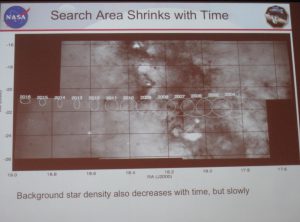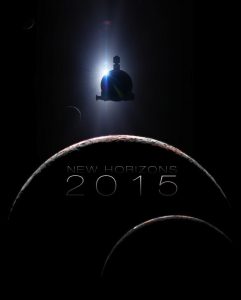Reposted from https://blogs.nasa.gov/mission-ames/2013/07/23/finding-that-distant-kbo-needle-in-a-deep-space-haystack/.
Next up at the Pluto Science Conference were a series of talks dedicated to recent work in the searches for another Kuiper Belt Object (KBO) for the New Horizons spacecraft to fly by after its Pluto fly-by. Fuel on board the New Horizons spacecraft after the July 2015 Pluto fly-by could enable a fly-by of a distant KBO in the late 2010s through 2020s, pending identification of targets reachable within New Horizon’s remaining fuel budget.
John Spencer (SwRI) has been leading the ground based campaign to search for New Horizons’ next target. With an on board ~0.13 km/s delta-v (measure of propellant), traveling at 14 km/s, this translated to a ~0.5 deg half-angle cone through the Kuiper Belt for accessible targets, a type of “survey beam.” Previous KBO searches had been for R>26.0 over 1-2 degrees. But right now Pluto is in Sagittarius which is in the direction of the Galactic Center and there are a lot of other stars in the field that make searching for a slowly-moving object, this KBO, difficult.
Above are what the star fields the team is inspecting look like. They observe the same star field night after night and look for shifts in a object between frames, indicating it’s a KBO and not one of the “fixed stars.”
“Known objects in the Kuiper belt, derived from data from the Minor Planet Center. The pronounced gap at the bottom is due to difficulties in detection against the background of the plane of the Milky Way.” This is exactly where John Spencer and his team are focusing their efforts because a subsection of that part of the sky is what is reachable by the New Horizons spacecraft after 2015. Image taken from http://en.wikipedia.org/wiki/Kuiper_belt.
The ground based search program area is entering a sweet spot, where they can cover a smaller area of sky from the Earth that falls within the expected New Horizons travel zone.
The team has found 31 objects from 2011 data including a TNO. However, as of 2012 season, they have not found an object that could have a fly-by encounter by the New Horizons spacecraft. But there are three objects (2011 JW31, 2011 JY31, 2011 HZ102) that New Horizons could get to within 0.15-0.2 AU of in 2018-2019. The team is in the middle of the 2013 observing season and based on the current number densities they are predicting to see 1.78 objects down to R=26.0mag and 4.15 objects in 26.5 mag.
Alex Parker (one more month at Harvard before moving to Berkeley) provided a more in depth view of unique observations New Horizons can still make of these long-distance KBO fly-by, that is, a fly-by in the 0.1-0.2 AU range of the spacecraft. At 0.2 AU range, New Horizons’ LORRI will have 140 km/pixel range compared to our “sharpest eyes” by Hubble at 1200 km /pixel from low-Earth orbit.
His excitement over the unique discovery space New Horizons provides that you cannot get from anywhere else: Proximity. High angular resolution. High phase angles.
He’s been studying trans-Neptunian binaries as binaries provide a direct mechanism to measure their masses. “Wide” Kuiper Belt binaries have been discovered already (e.g. Gemini observations of wide binaries 2006 BR284 separated by 0.82 arcseconds; 2000 CF105 separated by 0.95 arcseconds).
To visualize a ride on looking over the New Horizons shoulders as it journeys into the Kuiper belt, check out this one of Alex Parker’s visualizations at Vimeo.com/alexhp/newhorizons.
Make note to hold onto your seat when the craft enters the Cold Kuiper Belt region in 2018!
Susan Benecchi (Carnegie Institute) rounded out the talks with HST Follow-Up Observations of Long-Range Candidates for New Horizons post Pluto. They observed 2011 JW31, 2011 JY31, and 2011 HZ102 with HST. Those objects had been detected with the KBO ground based search program described by John Spencer and Alex Parker (previous presentations). Her team has not confirmed detection of 2011 JW31. Her team has confirmed the colors of the two other objects being “red” which is consistent with the Cold Classical Population (i.e. primordial). Implications for New Horizons: HST can provide this extra characterization step for new candidates.
Gustavo Beneditti-Rossi (Brazil) described a summary of “Astrometric Analysis of 15 years of Pluto Observations.” Using the Pico dos Dias Observatory (1.6m and 0.6m telescopes), they monitored Pluto-Charon (which is not separated in their data) for 154 nights over 1995 to 2012. They do refraction correction (due to viewing angle from earth) and photo-center correction (due to the fact they cannot separate Pluto from Charon). And show that their tracking of Pluto’s location is in agreement with occultation data.
To end this post, I could not resist showing you Alex Parker’s vision of what New Horizons brings to this field of study. He created this montage of images illustrating the proximity (within artistic license) and equally important the high phase (objects as crescents) and high angular resolution (we can see surface features), all that New Horizons will provide in 2015 that no other observation platform can.
2015 will be the “Year of Pluto” and so much more!




